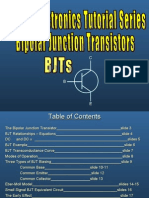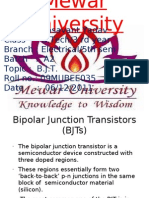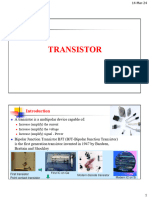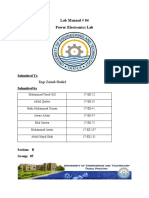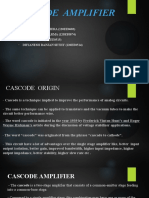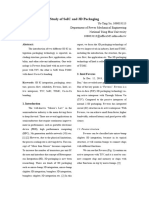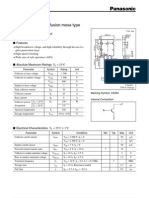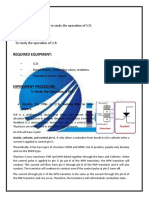CHAPTER 4: BIPOLAR JUNCTION TRANSISTORS (BJTs)
Chapter Outline
4.1 Device Structure and Physical Operation
4.2 Current-Voltage Characteristics
4.3 The BJT as an Amplifier and as a Switch
4.4 BJT Circuits at DC
4.5 Biasing in BJT Amplifier Circuits
4.6 Small-Signal Operation and Models
4.7 Single-Stage BJT Amplifiers
4.8 The Basic BJT Digital Logic Inverter
1
� W. Shockley
J. Bardeen
First BJT was invented in 1947 by W. Shockley, J. Bardeen and W. H.
Brattain in Bell lab, USA. W. H. Brattain
2
�Microphone
amplifier
Temperature
sensor amplifier
3
� NOR Gate
Integrated Circuit
4
�4.1 DEVICE STRUCTURE AND PHYSICAL OPERATION
5
� Remind:
- Diffusion current
- Drift current
- +
- +
Emitter injection efficiency 𝛾 = 𝑖𝐸𝑛 Τ(𝑖𝐸𝑛 + 𝑖𝐸𝑝 )
Base transport factor 𝛼 𝑇 = 𝑖𝐶𝑛 Τ𝑖𝐸𝑛
Common-base current gain α = 𝑖𝐶𝑛 Τ𝑖𝐸 = 𝛾𝛼 𝑇 < 1
6
�7
� Collector current iC iCn = I S eVBE / VT
iC
Base current iB =
Emitter current
Current gain
Common-emitter current gain
= / (1 − )
Ground
8
� Equivalent Circuit Model
iB
B C
𝑣𝐵𝐸
ൗ𝑛𝑉
𝑖𝐶 = 𝐼𝑆 𝑒 𝑇 = 𝛼𝐼𝐸 = 𝐼𝑆
iB 𝑖𝐶 = 𝛽𝑖𝐶
𝐼𝑆 /𝛽 DB
B
+
vBE DE iE
-
𝑖𝐸 = 𝑖𝐶 + 𝑖𝐵 = 𝛽 + 1 𝑖 𝐵 E
= 𝑖𝐶 Τ𝛼 = 𝐼𝑆 /𝛼
E
π- Model
T- Model
9
��+ - + -
11
� iB
ic
IE = IC + IB
12
�Collector current
iC iCn = I S eVEB / VT
iC
iB =
Base current
Emitter current
Current gain
Common-base current gain Common-Emitter current gain
= / (1 − )
13
�Equivalent Circuit Model
𝑖𝐸 = 𝑖𝐶 + 𝑖𝐵 = 𝛽 + 1 𝑖𝐵
+ = 𝑖𝐶 Τ𝛼 = 𝐼𝑆 /𝛼
vEB DE E
-
iB iE
B
+ 𝑣𝐸𝐵
ൗ𝑛𝑉
𝑖𝐶 = 𝐼𝑆 𝑒 𝑇 = 𝛼𝐼𝐸 = 𝐼𝑆
vEB 𝐼 /𝛽 DB
𝑆
𝑣𝐵𝐸 -
ൗ𝑛𝑉
𝑖𝐶 = 𝐼𝑆 𝑒 𝑇 = 𝛼𝐼𝐸 = 𝐼𝑆 iB
B C
T- Model π- Model
� 4.2 CURRENT-VOLTAGE CHARACTERISTICS
Summary of the BJT current – voltage relationship in the active mode
𝑣𝐸𝐵
ൗ𝑉
𝑣𝐵𝐸 𝑖𝐸 = 𝑖𝐶 + 𝑖𝐵 𝑖𝐶 = 𝐼𝑆 𝑒 𝑇
ൗ𝑉
𝑖𝐶 = 𝐼𝑆 𝑒 𝑇
𝛽
𝛼= 𝑣𝐸𝐵
ൗ𝑉
𝑣𝐵𝐸
ൗ𝑉 𝛽+1 𝑖𝐶 𝐼𝑆 𝑒 𝑇
𝑖𝐶 𝐼𝑆 𝑒 𝑇 𝑖𝐵 = =
𝑖𝐵 = = 𝛽 𝛽
𝛽 𝛽 𝛼
𝛽=
1−𝛼
𝑣𝐵𝐸 𝑣𝐸𝐵
ൗ𝑉 ൗ𝑉
𝑖𝐶 𝐼𝑆 𝑒 𝑇 𝑖𝐶 𝐼𝑆 𝑒 𝑇
𝑖𝐸 = = 𝑖𝐸 = =
𝛼 𝛼 𝛼 𝛼
�Common-Emitter Output Characteristics (I)
Early Effect
�Common-Emitter Output Characteristics (II)
� ICsat
βIB
ICsat
VCEoff V
18 CEsat
VCEsat
�iC
∆iC
∆vCE vCE
19
�Example: β = 100, VLED = 1.7V. Find IC and VC
Ans: IB = (9 – 0.7)/100K = 8.3 X 10-2 mA
IC = IB.100 = 8.3 mA
VC = 9 – 8.3 x 0.68 - 1.7 = 1.656V
R = 100KΩ
Example: β = 100, VLED = 1.7V. Find R to obtain
transistor saturation
Ans: Icsat = (9 – 1.7 – 0.2)/680 = 10.44 mA
𝐼
𝛽𝑓𝑜𝑟𝑐𝑒 ≪ 𝛽 𝑜𝑟 𝑐𝑠𝑎𝑡 ≪ 100, choose
𝐼𝐵
IB = Icsat/10 = 1.044 mA
R = (9 – 0.7)/IB = 7.95 K
